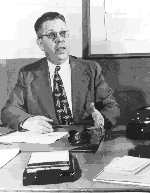November 2001


Greetings microwave patriots!
For those of you who might be asking "what's with the flags?", Pearl Harbor Day is coming up, so I wanted you to all know which side P-N Designs is on. While we are on the subject, those of you who have tied a plastic flag that was made in China to the antenna of your Lexus Qx4 SUV that was made in Japan so you can watch it shred itself at 70 miles per hour while you burn 40 gallons of premium gas each week imported from our "friends" the Saudis, please rethink the whole deal. Then take the ripped up flag off your car before it ends up as red white and blue litter.
What's this month's microwave lesson? Before you wireless whippersnappers were born, the microwave industry served only one master, and that was the defense industry. Microwave technology grew up in the '30s and '40s, and American microwave engineers played no small part in turning the tide on the Third Reich and the Empire of the Sun during WWII. The U.S. set up the Radiation Laboraties at M.I.T. in 1940 specifically to exploit microwave electronics. During its short lifetime (about 5 years), as many as 4,000 RadLab scientists were involved in microwave research in support of the war effort. Their work formed the basis for microwave textbooks for many years to come.
 |
Our allies the Brits knew they had a good thing going when they developed a high-power magnetron to power the radar sites that would give them the jump on the Luftwaffe. Trouble was, the complicated machining procedure that they were using employed half the expert machinists in the UK using sophisticated equipment to turn out 17 pieces per week. They came to the USA looking for help in mass producing the part. At the request of the Rad Lab, the tube was shown to Percy Spencer, a true microwave engineering genious at the fledgling Raytheon company, who enquired after the meeting if he might take home the magnetron cavities to study it. A bold move, since everything about the magnetron was classified top secret. Desperate times call for desperate moves, so his wish was granted. |
Spencer returned on Monday full of suggestions for process improvements, and Raytheon was soon awarded a contract to build the British "Maggie". Within a few months 2600 tubes per day were being shipped from Raytheon's factory in Newton, Massachusetts, with 40% improved power efficiency.

How did Spencer do it? Among other tricks, he realized that the magnetron cavity could be built up by brazing together of a handful of small stamped flanges, much like stacking up a bunch of ordinary washers of different sizes.
The proximity fuze is another great example of microwave technology of WWII kicking butt. A metal storm of buzz bombs was raining in London, making the V-1 one of the most successful weapons of terror of all time. Anti-aircraft batteries were having poor luck shooting down these crude cruise missiles, owing to their high speed and small size. Enter the Applied Physics Laboratory of John's Hopkins University....
| Using vacuum tube technology, they created a miniature Doppler radar that fit in the head of an artillery shell. The radar was able to detect when an target was close by, and fuzed the shell at just the right moment. This feat may seem like no big deal today, but remember that APL needed to figure out how to design glass-encapsulated vacuum tubes that could withstand 20,000 Gs! As George S. Patton put it, "The funny fuze won the Battle of the Bulge for us. I think that when all armies get this shell we will have to devise some new method of warfare." Some 25 million VT (variable timing) Mark 53 fuzes were built in American factories during the war. |
 |
 |
After the war, guided missile technology took off thanks to radar engineers and a steady stream of megabucks from Uncle Sam. Hughes Aircraft's Falcon missile scored the first successful air-to-air intercept in 1952. The original Falcon weighed 110 pounds at launch, including a 29 pound high-explosive warhead. The nose was fitted with a semi-active radar receiver, in which the launching aircraft's radar transmitter tracks the target and the missile homes on microwave energy reflected back from the target. Maximum speed of the Falcon missile was Mach 2.8, and effective range was about 4 miles. It needed 30 seconds to warm up, not a particular advantage in a dog fight. |
I could go on with this lesson, but you get the picture. What does any of this have to do with today? Remember that microwave engineering still stands on the front lines of our defense, in radar, missiles, decoys, smart bombs, GPS and even a new "pain ray". Remember that while the lure of stock options sapped a lot of microwave talent to the wireless industry, it's a good thing that many microwave engineering patroits chose to remain working in defense. And it is fascinating work indeed. What would you rather do, work on a design team of 100 people trying to build a better $40 cell phone, or work on a team of 10 people trying to make a better millimeter-wave missile receiver for $100,000?
Remember that your stupid SUV's antenna is no place to display the American flag!
If you want to know how we can help you sell microwave products, drop us a line at marketing@microwaves101.com. If you want to help us with content for fame and fortune, drop an email and your favorite equation to techwriter@microwaves101.com. And remember to visit us first whenever you need microwave solutions!
Check out the Unknown Editor's amazing archives when you are looking for a way to screw off for a couple of hours or more!
Fan/hate mail can always be sent to UE@microwaves101.com